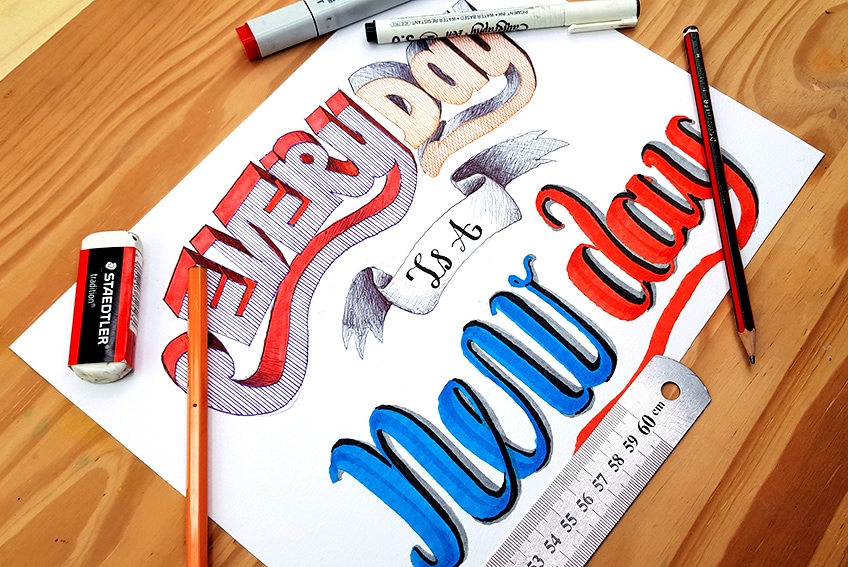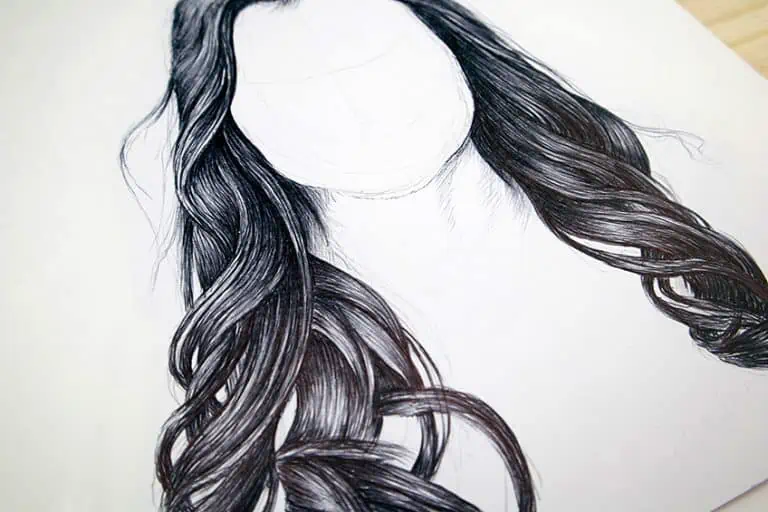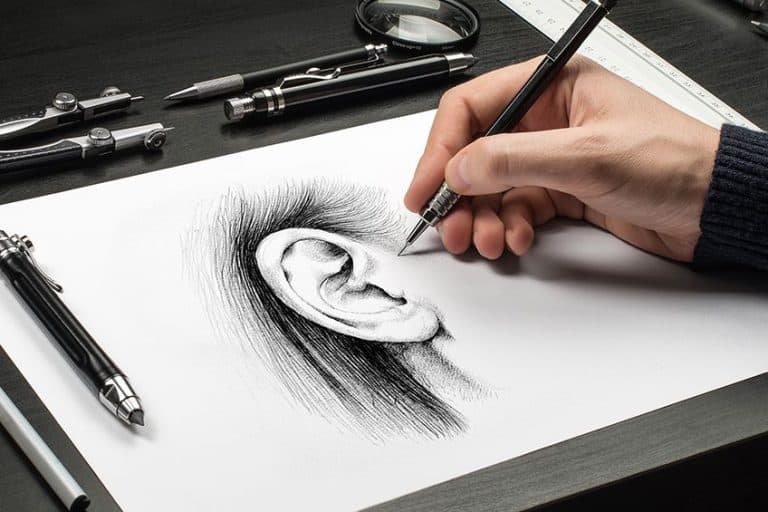Hand Lettering Guide for Beginners – Easy Lettering Tutorial
This post may contain affiliate links. We may earn a small commission from purchases made through them, at no additional cost to you.
Hand lettering is a great skill to learn; it can enhance your hand lettering activities as well as provide you with an additional feature for other creative projects. Hand lettering is a great way to also explore different font styles and how to achieve different styles with different tools. Hand-letter designs can provide you with a unique perspective into the genre of texts and typography. Creative lettering is a great way to refine your lettering skills that can easily be utilized within both a paper and digital medium. In this lettering guide, we will look at the basic process of utilizing our tools and how we can achieve various outcomes through a creative lettering process. In this hand lettering guide for beginners, we will go through some simple tips and tricks that can help you to develop your hand lettering repertoire.
Table of Contents
A Simple Guide to Hand Lettering
In this lettering guide, we will go through some basic processes that can be utilized with some common tools used within the hand-letter design. Hand lettering fonts can be achieved in many ways with different tools. Utilizing a combination of tools is the best way to enrich your hand lettering artworks, as the combined styles give an artwork variety that makes it more interesting. Creative lettering is often simpler than it seems, once you know the process of putting different letter styles together. In this tutorial, we will work with some simple exercises that help us to utilize the tools that we are using. We want to use the different tools to achieve different hand lettering fonts, which we then can combine to create a hand-letter design. We do want to make sure we have some essential tools for the tutorial on hand lettering for beginners, so let us take a look and see what we will need.
Necessary Materials
This tutorial does require some specific tools, this is because we want to understand how to create a combination of different hand lettering styles. We want to create some differences in our hand-letter design, using brush-like tools as well as graphics-styled tools. Creating blocky, calligraphy, brush, graffiti and many other styles can be accomplished if we have the right tools. Using tools like Copic, koi brush, micron, and calligraphy-styled pens are going to provide us with more creative freedom. The greater the variety of tools, the greater the freedom we will have to create different types of hand lettering styles. We will also want to use a pencil, having a pencil to create rough sketches is a great way to prevent ourselves from making any unnecessary mistakes. We will also want to have an eraser on hand, a ruler, and lastly, some paper. Below is a list of items that you can buy online:
- Calligraphy Pen
- Copic Markers
- Micron Pens
- Pencil
- Koi Brush Pen
- Eraser
- Ruler
- Paper (any paper will do)
A Tutorial on Lettering For Beginners
In this tutorial on hand lettering, we will be going over a few tips and tricks to enhance our hand-letter design skills. We want to begin by understanding what our tools are capable of, which means we will go through a few exercises to practice using different drawing tools. Once you familiarize yourself with the tools, you can then proceed to a more advanced stage where you write out different words. Another aspect that is important to hand lettering is adding details. Adding different details such as spacing, curves, and other tricks to change your letter formation can be a great addition to your creative lettering. From there we will explore how we can put these different tips and tricks into a finalized piece. This tutorial is intended to guide you on ideas that you can utilize within your hand lettering artworks, that being said, let us get started!
Familiarize Yourself With Your Tools
A key part of understanding how to hand letters is to understand how to use your tools. Using a variety of different tools will give your hand-letter design a more interesting look, ultimately enhancing your hand lettering artwork. Understanding how to use our tools will help us to implement a variety and different writing techniques more seamlessly. That being said, let us take a look at a few different hand-lettering exercises we can do that will help us with our creative lettering.
Creating Lines and Letters
With the different tools available to you, start to play around with creating different lines and letters as you proceed to try out each tool. We want to see the potential of each tool; this means each tool is going to achieve a different result and we want to explore how we can do that by experimenting with each of them.

Keep it easy and loose, not putting too much pressure on yourself. An important part of trying different tools is to see what you discover with each material through an exploration of different letter formations, strokes, and lines. A large part of what makes hand lettering so great is the aspect of learning your style, which you will only achieve by exploring what different materials are capable of.
When you familiarize yourself with brush-like tools, they are going to achieve different results than of marker-styled tools. The same goes for the other tools, each tool will have unique results which are what will enrich your hand lettering artistry.

Another good suggestion is to write out different letters, practicing different movements and strokes with your different tools. experimenting with different lines, letters and strokes will ultimately provide you with the motor skill practice that is necessary when using these tools in hand lettering artwork.

Exploring Letter Styles
Once you have a few tools to work with, it is essential to do your research and explore different letter styles. Exploring different letter styles is going to give you conceptual knowledge, helping you navigate how to utilize the tools to achieve some common hand-lettering styles. For instance, with a black Copic marker, pencil, and black pen, you can easily create 3D lettering.

Another common style that can be achieved is graffiti style. For instance, if you have Copic markers available, this tool can also be utilized to create some great graffiti-style lettering. Markers can be a great way to color in larger surface areas, which allows us to color letters quite easily.

The combination of Copic markers and micron is often utilized within the hand-lettering design. This is because they are capable of achieving a variety of different lettering styles by nature of the design of the tools. With Copic markers, you can create larger calligraphy-styled text which can be refined with further details using a pen.

Another essential tool that is easily accessible is the brush pen. Brush pens come in all sorts of different sizes, and this can be a great way to achieve finer calligraphy styles texts. This is a broad genre that can be achieved with all sorts of different tools and should be explored and researched.

Another common style of hand lettering is block letter styles, these can be achieved with simple markers, pencils, and pens. This is another great aspect of hand lettering and provides you with more professional and formal-looking hand-lettering designs.
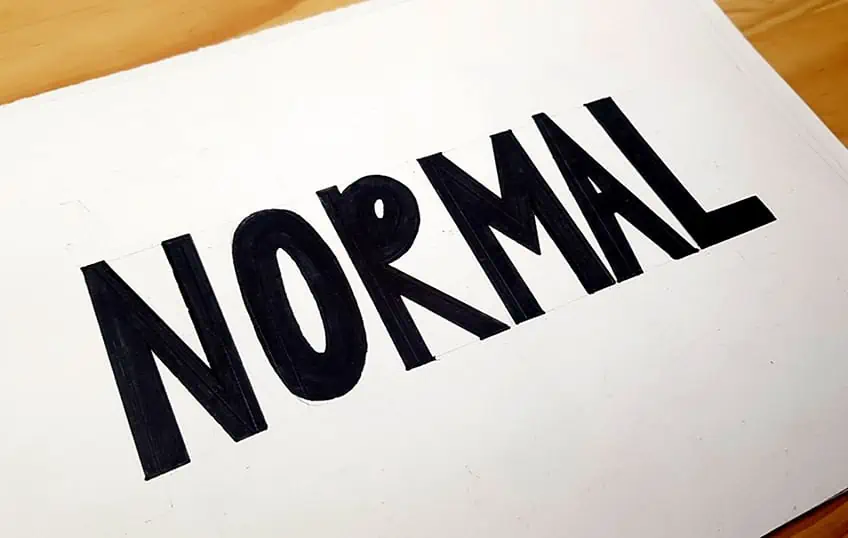
Using simple tools can often be a great way to explore more simplistic and timeless font styles, however, it’s all a matter of what you desire. If you are looking to create sleek and professional-looking texts, then pursuing serif style fonts and texts can be a great and simple hand-lettering style to achieve using the basics, such as a ruler, pen, and pencil.

Practicing Words
Once you have familiarized yourself with your tools and experimented with different strokes, then the next stage would be to practice writing out words. The writing process will be different for each tool as each tool comes with its unique outcome. This is because each tool is different, which means we want to understand how to use them both individually and together to form words.
Writing Out Words With Different Tools
The best way to start is to take a few different pens, markers, and brush pens, and then proceed to write out words on a single piece of paper. By doing this we will have an opportunity to compare line, form, spacing, and other details that how different mediums compare with one another.
Perhaps choose a single word, by choosing a single word you can start to compare letter structures to one another. As you write out a word with each tool, you can proceed to do this in rows going down the page. This will allow you to see how each letter differs from the previous word drawn and written out with different tools.

Again, you want to consider the different processes of writing and drawing that different tools are capable of. This means that when you use a brush-like pen compared to a marker, the rules and processes are different for forming letters. However, this is why we experiment and practice so that we can see what is possible and how different styles work together.
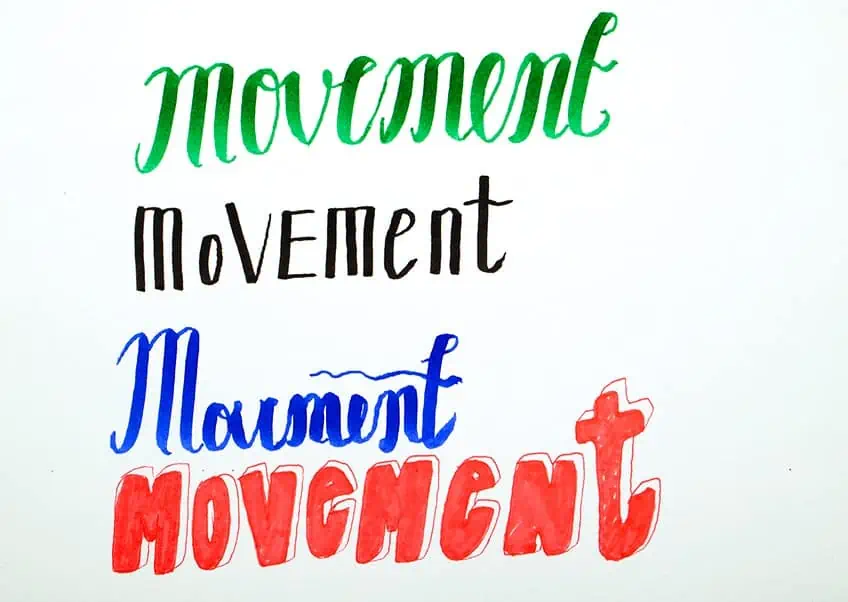
Writing Out a Word With a Combination of Tools.
This is where you start to explore the combinations of different letter styles. Hand lettering is all a matter of the desired outcome. The subjective process of hand lettering starts with exploring and seeing what exactly you would like to achieve in your hand lettering style. This means another great way to practice hand lettering is to write out a word with a style combination to give yourself options.
Creating a Final Piece
Once we have explored different hand lettering styles and allowed ourselves some freedom to experiment and practice hand lettering, we can now start to create a hand-lettering piece. Before you begin with your final hand lettering piece, you want to make sure you have decided on a phrase or sentence for your artwork.
The process of creating a hand-lettering design should be a freeing experience. This means you should first and foremost have fun and enjoy brainstorming what the outcome should be. Generally, the process starts by figuring out the composition of your letters on a page and simply starting with a rough sketch of your desired lettering style.

Again, if you want to create something a little funky and colorful then that is up to you, however, you can pursue more of a formal quality in your hand lettering artwork if that is your intention. As you draw out your hand lettering styles you want to remember how different tools that you practiced with create different styles. For instance, how pens and rulers can be used to create 3D effects.
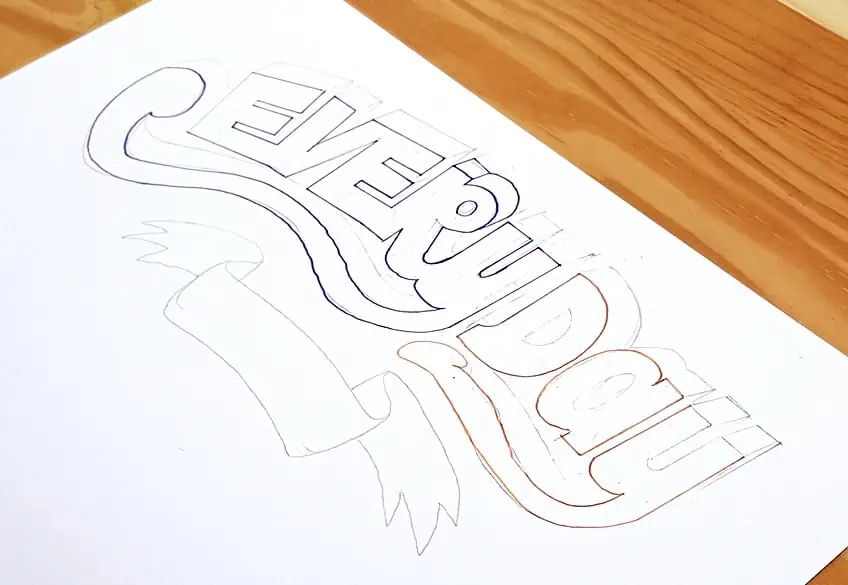
As you create your lettering on your page you want to take your time with the process, respecting the drawing process as something that requires attention. You can also play around with adding effects to your lettering by drawing out shapes to give them length, or by dividing your lettering with other details.

Coloring is another massive component of your finalized piece and how it can create a particular look within your hand-lettering design. However, not just color but details such as shading, linework, spacing, and shape, just to mention a few. You want to consider how your letters are formed and placed on a page and next to one another.

Using the technique of contrast can also give your lettering a boosted quality. For instance, this can be achieved by adding lighter color to the face of your letters whilst creating darker shading around or in other areas of the letter. Again, it’s all a matter of practice and then putting what you have practiced into a hand lettering artwork.
Again, creating detailing around your hand lettering is another way to enhance your hand lettering design skills. A great idea is to break up your lettering styles with other features such as ribbon shapes, boxes, or any other feature you believe will be a great addition to your hand lettering piece.

As you explore adding different hand lettering styles together, playing around with scale and structure should always be a guiding force in the back of your mind. You want to consider which style works well on different scales and how they can be utilized with other hand-lettering styles.
Another key guiding force for hand lettering is variety. Variety will always be a great way of keeping your hand lettering artwork interesting. Using variety in style is a great principle to remember as a hand lettering guide for beginners. If you have used a specific tool already, explore another within your artwork.
It is also important to remember how tools can be used together to create beautiful letter structures. Using tools in tandem with one another can often enhance the letter style itself. This is something to explore before pursuing a final piece.

Remember, hand lettering is completely subjective but you will not know exactly what you would like unless you explore what your tools are capable of. By experimenting and practicing, you will give yourself a better chance of creating something more suited to your interests. Most importantly, having fun learning and exploring creative lettering.

Tips to Remember
- Practice. The only way to get better is by practicing your hand lettering skills.
- Experiment. try different letter styles and combinations.
- Details go a long way. This means considering the small things, such as spacing, structure, curving your letters, scale, and how they are formed on a page.
- Use other tools. This could be rulers, rounded objects, or anything to help you form letters.
- Take your time. Hand lettering is an art form, it should be approached with patience and time.
- Most importantly, have fun. Have fun with the process of learning skills within this hand lettering guide for beginners.
In this hand lettering guide for beginners, you are taken through the basic ideas and processes associated with creative lettering. However, there is a lot you can adapt and change to create your hand-lettering styles. This hand lettering guide for beginners shows you how to practice hand lettering, giving you the tools to develop your hand lettering alphabet, word structures, and artworks. Use this resource as a guide for reference and explore your hand-lettering styles.
Frequently Asked Questions
What Details Can I Add to My Hand Lettering?
Beyond Letter formation itself, hand lettering can be improved by a few additional details. Details such as spacing can give the text a fuller feeling, this means spacing in between individual letters as well as words. Different hand-letter fonts can also be used more effectively when considering their scale, different sizes of words and letters can be a great way to change the feel of different text. Another great detail to add to lettering is shading, shading is a great way of giving text dimensions, making it stick out from the page. There are many ways to give your creative lettering a more interesting feel, so experimentation should always be a key process when exploring the variations and combinations with hand-letter design.
How Do I Get Better at Hand Lettering?
Experimentation and practice. These are the two ingredients that should always be implemented into a creative lettering practice, especially when working with different mediums. Exploring the potential of your different tools is a great way to bring out the best in your hand lettering. You could do this by practicing lettering alphabets, shapes, and various strokes and lines. Having a practiced hand with various mediums is always a great way to create variety within your repertoire of hand lettering. However, lettering for beginners should be approached more freely which means you should not worry too much about special tools but rather just focus on using what you got. Exploring the full potential of the materials available is a great way to exercise your creative thinking. This can be anything from a pencil to a pen, as long as you start with what you have.
What Are the Different Styles of Lettering?
When you have the opportunity to explore different lettering styles, achieved with different equipment, this is when you can unlock a variety of options to use within your hand lettering artworks. Lettering styles that range from loose and brush calligraphy to more blocky styles like serif can be achieved with different tools. So having more tools is always better because it provides you with more options. Other lettering styles include graffiti, brush lettering, block lettering, 3D lettering, and many more. A good idea is to scroll through the internet and explore letter variations and see how the tools that are available to you can develop a variety of different texts and letter formations. Most importantly, try to create your lettering style by taking different features and techniques that can be found in some more classic and popular lettering techniques.
Matthew Matthysen is a multidisciplinary artist. He completed his fine art degree, majoring in History of Art and Contemporary Drawing Practice at the University of Witwatersrand, South Africa. Before joining acrylgiessen In 2020, Matthew worked part-time as an art teacher at Reddford Blue Hills High school. Matthew creates drawing and painting tutorials for acrylgiessen and captures them not only photographically and in written form. He also records the creation of his works in his own creative studio as in video format, from which later with a voiceover and a video editor also drawing tutorials for the Youtube channel of acrylgiessen are created.
Learn more about Matthew Matthysen and about acrylgiessen.
